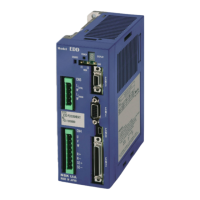12. Troubleshooting
— 12-2 —
12.2.1. Power Trouble
Table 12-3: Troubleshooting for power problem
No control power supplied.
Check the control power voltage at the connector of the Driver Unit.
CPU is not functioning.
• The power is on but the CPU is not
functioning.
Refer to “CPU Error” in “11.3. Causes and Remedy.”
If no failure is found in the above checks, the Driver Unit may be
defective. Replace it referring to “Appendix 5: Procedure for Replacing
Driver Unit Model EDD.”
12.2.2. Motor Trouble
Table 12-4: Troubleshooting for Motor trouble
Wrong combination of Motor and Driver
Unit.
Check if the combination of the Motor and the Driver Unit is correct.
Alarm or warning is occurring.
Identify a warning or an alarm.
Overload or mechanical interference with
other part.
The Motor is locked by a part of surrounding mechanism.
Check for mechanical interference with other part of mechanism.
Positioning is not completed.
• (As the sequence of the total System) The
System recognizes that the previous
positioning command is not executed.
• (In case of a program operation)
executing sequence does not complete the
previous positioning command.)
4-1) Overload or interference with the
equipment into which the Motor is
installed.
• The Motor is not locked, but an excessive
friction load is applied to the Motor due to
the mechanical interference with the
surrounding mechanism.
4-2) Poor tuning of servo gains
4-3) In the middle of processing a
positioning command.
• Executing a positioning command
• Executing a program operation caused by
the parameter OE2.
Confirm if the output BUSY is closed or monitor the state of Input and
output by the monitor IO0/RP.
If the BUSY signal is closed, the System is executing a positioning
command.
4-1): Check the mechanical interference with the surrounding mechanism.
4-2): Refer to “5. Tuning” for adequate tuning.
4-3):
• Wait for completion of the positioning command.
• Terminate the positioning command (such as the command JOG).
• Input the STP (Stop) command to interrupt the positioning operation.
No torque output because the parameter
TL is set to zero (TL0).
Check if the parameter TL100 is specified by the ?TL command.
If not, the setting may be altered for some reason. (Normally it should be
TL100.)
Enter TL100 for 100% output torque. (Requires an entry of the password.
Motor servo is deactivated by the
command MO (Servo off).
Enter the command SV to activate the Motor servo.
The objective program channel is not
selected in a program operation.
Use the command IO0 to confirm if the objective channel is selected.
Defective Cable, Motor and/or Driver
Unit.
Refer to “Appendix 2: How to Check Motor Condition.” Replace the cable
of the Motor if necessary.
If no failure is found in the Cable and the Motor, the Driver Unit may be
defective. Replace it referring to “Appendix 5: Procedure for Replacing
Driver Unit Model EDD.”

